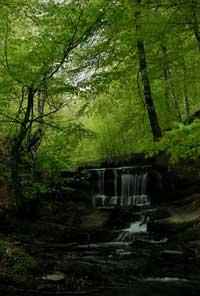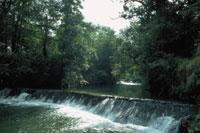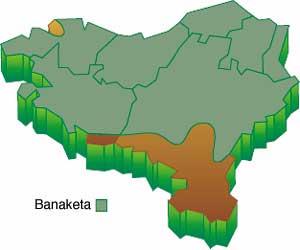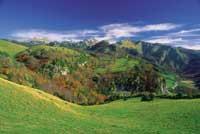It was normal... common crab
1995/12/01 Elosegi Irurtia, Migel M. Iturria: Elhuyar aldizkaria

As most people, of so much abundance, have almost completely disappeared the crab of river ( Austropotamobius pallipes) in the last 20 years. The lack of knowledge, the painful situation of aquatic ecosystems, and a long etcetera that we will analyze, unfortunately offer a dark future to this magnificent animal that played such an important role in rivers and streams. The common crab (or autochthonous) is an invertebrate dressed in hard shell. From the tip of the end to the back, it has a length of 11 cm and its weight is usually around 80 g.
Of the 10 legs of this decapod, the first pair is equipped with strong clamps. Contrary to what many people believe, the crab goes forward and only swim backwards tightly contracting the tail under the body. The color can vary, always predominating the dark or brown-green olives. Those who have only seen the crab on the plate will say it is red. But this is because when it is cooked, the first of the two pigments it has in the shell (blue and red) gets rid of the heat and only the red pigmentation remains.
To know this species, however, these characteristics are not enough, since in our rivers and streams there are two other species of American crab of origin: the red crab ( Procambarus clarkii) and the signal crab ( Pacifastacus leniusculus). The main differences between these three species are:
- As the name suggests, the red crab is reddish. The premises and the signposted ones are, in most cases, very brown.
- The autochthonous crab is somewhat smaller than the signal and the latter is also easily separable by having a marked “sign” or white scar on the clamps.
- Continuing with the tongs, those of the common crab are granular. Those of the signal, instead, soft and thorny red.
- In addition to morphological differences, each species is found in different habitats. Red crab, for example, is attracted by fairly slow, temperate, sometimes dirty waters. The other two appear in clean waters, but their crab usually remains at the top of the rivers, since the signal predominates in warmer waters.

Therefore, the common crab is a kind of clean, fresh and oxygenated water. The middle areas are more appropriate for the species than the high mountain streams. The best development occurs in calcareous waters, due to the importance of calcium in the formation of the exoskeleton. On the other hand, he likes basins rich in dens, rocky and with numerous holes. It can inhabit not only rivers and streams, but also lakes, reservoirs and canals.
It usually stays under the stone or vegetation during the day, until at dusk it goes out to eat. Then, to fill the stomach, start looking for plants, insects, larvae, dead animals, etc. Crab is an omnivore and scavenger that, eating organic matter, helps balance the balance and cleanliness of freshwater ecosystems.
The development of gonads begins in June and reaches its peak in September-October. The males then enter into heat and begin to look for females. To fertilize, the males leave the spermatoforum between the legs of the females and a racket occurs several days later. The female lays an average of 60 eggs and carries them tied in the abdomen for 6 months until they hatch in spring. Both in the development of gonads, the hatching of eggs, and in other processes of life of this animal, water temperature is very important. After hatching, larvae are born and pass through different stages (developmental state), adopting the form of adults and separating several weeks from their mother. Mortality in the first months of life of crabs can be very high.

The fact that the crab's body is covered with hard shells causes many growth problems and can only grow when you remove that outer shell to form the next shell. This time period is usually very serious for the crab, as it is in a situation of unprotection and sprawl. Until the old shell is removed and the new shell is formed, it takes a few days and about 48 hours to harden.
As already mentioned, calcium makes it much easier to do so in alkaline waters. During the deck change and in order to avoid risks, it will not come out to feed. The first year will change a shell 5-7 times and adults 2 times a year: spring and autumn. It is a kind of relatively slow growth and will take 3-4 years to reach sexual maturity.
From being where it is to almost disappear

This crustacean occupied in its historical distribution a central and southern Europe, the British Isles, etc. However, the current situation is very different, practically disappeared in the Iberian Peninsula. As for the situation in Euskal Herria, we could say the same thing. Formerly, in most rivers and streams of Euskal Herria the crab was abundant. The habit of fishing or eating crab seemed not to have too much influence on the populations. In a few years, however, all populations have suffered a drastic decline to virtually disappear. Why such a disaster?
One of the main causes of this disease is the so-called afanomicosis produced by the fungus Aphanomyces astaci, which in some places has been known as the “crab epidemic”. This fungus, probably, would reach our rivers through the crabs that were brought from America to Europe and in a few years destroyed local populations. As a result of this oddo, the crabs are weakened by the shell and their legs are paralyzed and death comes to them in 10-15 days. Mortality is generally 100%.
It seems that afanomicosis first appeared in Italy at the end of the last century and then spread throughout Europe. The first mass deaths in Spain occurred in 1958 in Valladolid and in 1965 in Soria. In 1979 it spread throughout Spain. In Euskal Herria also began to expand mortality in 1978 and its formation could be associated with the red crab or crab sign that was introduced in the rivers of America. Despite their illness, they are species that can survive and when they enter our rivers, they became contaminated and died. In addition to American crabs, fishermen's catiuscos and grills can also be conductors of the anomaly, multiplying the problem.

The consequences were regrettable. Native crabs were left in mountain streams and isolated populations, increasingly difficult to move forward. As the common crab disappears, there has been an imbalance in the ecosystem in which it lived. Increased eutrophication and acidification of water, decreased levels of dissolved oxygen, proliferation of aquatic plants and animals, decrease of others, etc.
In addition, all this can be added the economic value of fishing. Between 1978 and 1987, for example, it is estimated that the economic value of unsolicited fishing licenses for the Spanish State Administration was 2 billion pesetas. In 1924, 200 kilos of crab were taken daily in fishing season from Vitoria to San Sebastián. In 1975 more than 4 million specimens were still captured in Alava, but since then the figures were going to decrease dramatically. In the kitchen it is so appreciated that currently in the Autonomous Community of the Basque Country they consume about 500,000 kilos of crabs of river a year, but of red color ( Procambarus clarkii). However, you cannot fish or eat.

In any case, the disappearance of native crabs cannot be accused only of pests. Undoubtedly, the direct or indirect actions of the human being have had a great influence. Thus, river pollution, changes in river basins, vegetation cuts, overfishing, etc. could have the same blame on the extinction of this species as afanomicosis.
What to do and what not to do?
As on other occasions, we are facing the extinction of an animal from the hand of man, but is there anything to do in favor of this species? To begin with, we must remember that ignorance is very great, which makes it difficult to find a suitable solution. Detection of the microscopic fungus Aphanomyces astaci is very difficult and only researchers who are doing so can do it reliably. It is difficult, therefore, to say that for anyone else the crabs are contaminated. Therefore, the first step is to avoid the use of crabs for repopulations, unless it is controlled by experts. Nor those who say they are “crabs without pests”, since the uncontrolled can be sold with that name.
Let us remember that, according to the latest studies, the crab with signal ( Pacifastacus leniusculus) is the driver of the pest, a species used in various areas of the Basque Autonomous Community. Therefore, the species that is being “sold” as an ecological representative able to withstand the disease can be one of the factors that harm our last conventional crabs.
Consequently, it would be preferable not to repopulate the crab with signs or other allochthonous species; to carry out research to know the distribution, abundance and health status of all the crab species present in our rivers; to promote the conservation and/or recovery of the ecological state of the river basins; to plan the introduction of native crab in the waters without aphanomicosis; to confirm from the hand of experts the common crab populations;

In several places in Europe, the epidemic is being controlled and overcome, since the fungus cannot live more than one or two days without a host. Therefore, after the contamination of the fungi and the death of all the crabs, the fungus disappears and after a time can live the native crab again. The two necessary conditions for this are the suitability of the habitat and the absence of conductive crabs of the disease. We repeat the above: American species caused damage, but habitat alterations have also undeniably influenced the disappearance of native crabs.
As was clear, it will not be easy to solve this complicated problem in the short term and return to the populations of the common crab of yesteryear. With the effort of all, taking care of the rivers, respecting the last populations and leaving uncontrolled repopulations forever, we recover this elegant animal. Difficult, but not impossible!
Species: Austropotamobius pallipes |

Gai honi buruzko eduki gehiago
Elhuyarrek garatutako teknologia





